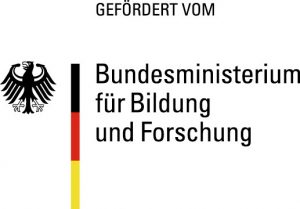
Prognose der Verkehrslage in der Region Hannover
Die primäre Anforderung der Verkehrsteilnehmer im Bereich des Straßenverkehrs ist die Kenntnis der aktuellen Verkehrslage. Diese basiert in der Regel auf der wirklich benötigten Reisezeit von sehr vielen Verkehrsteilnehmern, deren Daten häufig im Kontext von Routingdiensten abgegriffen werden.
Im Rahmen von Data4UrbanMobility wurden Werkzeuge entwickelt um eine ganglineinbasierte Prognose der Verkehrslage zu ermöglichen. Die folgende Abbildung zeigt eine Oberfläche auf der typische Ganglinienverläufe und Ausreißer visualisiert werden.
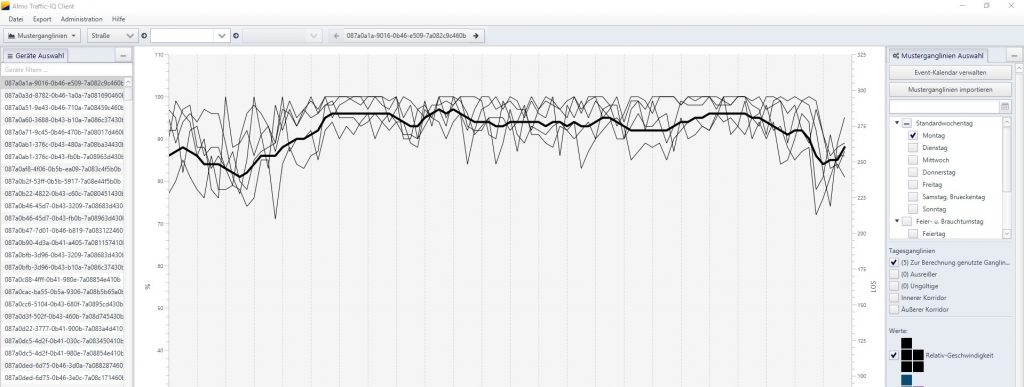
Die Prognose der Verkehrslage kann dann mittels einer Karte für den Endnutzer visualisert werden:
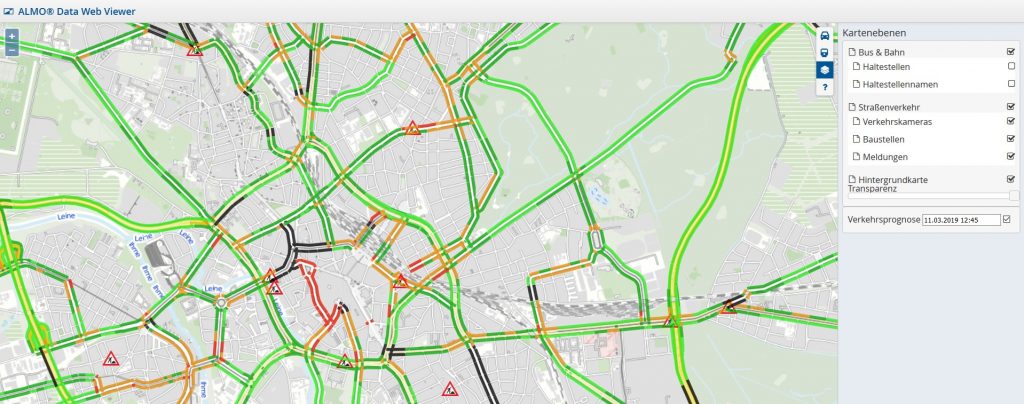
Erste Version der MIC-App bereitgestellt
Eine erste Version der MIC-App (Move in the City) konnte allen Partnerinnen und Partnern des Projekts und einer geschützten Nutzer*innengruppe der Öffentlichkeit zur Verfügung gestellt werden. Die mobile App MiC ist ein Instrument zur Datenerhebung.
Dabei verknüpft MiC – eine Entwicklung des Institute for Sustainable Urbanism ISU der TU Braunschweig und Projektionisten GmbH Hannover – das wachsende Bewusstsein und die Notwendigkeit für digitale Bürger*innenrechte mit den Potentialen mittels der Auswertung großer Datenmengen neue Formen der menschzentrierten Entwicklung von Stadt und Mobilität zu ermöglichen stellt eine Möglichkeit dar, sich aktiv als Bürgerwissenschaftlerin und Bürgerwissenschaftler an der Forschung und Entwicklung der Mobilität für alle in der Stadt der Zukunft zu beteiligen.
MiC erhebt – durch die Nutzerinnen und Nutzer gesteuert – Daten zu Strecken und Art der Fortbewegung. Diese Daten werden pseudonymisiert, so dass ein Rückschluss auf die jeweilige Person nicht mehr möglich ist. Wichtig ist die Vielzahl der Nutzerinnen und Nutzer – nicht die einzelne Bewegung. Die Stadt der Zukunft zeichnet sich aus durch den barrierearmen Zugang zu Mobilität und Erreichbarkeit für alle. Der holistische Ansatz der Forscherinnen und Forscher des Institute for Sustainable Urbanism ISU (TU Braunschweig) sowie der Projektbeteiligten betrachtet Stadt dabei auf verschiedenen Maßstabsebenen und bringt intelligente Planungen – wie z.B. die 5-Minuten Stadt –, Städtebau und innovative Technologien zusammen. Für ein umfassendes Verständnis individueller Mobilität und darauf aufbauende neue Methoden und Werkzeuge für integrierte Verkehrs- und Stadtplanung werden mittels der MiC-App uns umfangreiche und detaillierte Daten darüber geliefert, wie und auf welchem Wege wir uns in der Stadt fortbewegen.
Entwicklungsstand:
In der ersten Version ermöglicht das Stadtforschungstool MiC den Nutzer*innen durch eine einfach Handhabung das Starten und Beenden der „Tracking-Time“ (Bild 1). Wichtig ist, die Nutzer*innen entscheidet selber über den Zeitraum. Als erstes Ergebnis für die Nutzer*innen steht eine Zusammenfassung ihrer bisher aufgezeichneten Routen (Bild2). In den Einstellung (Bild 3) kann der Nutzer sich aktiv an Feedback beteiligen (Bild 4) sowie seinen Account und somit seiner zur Verfügung gestellten Daten löschen (Bild 5).
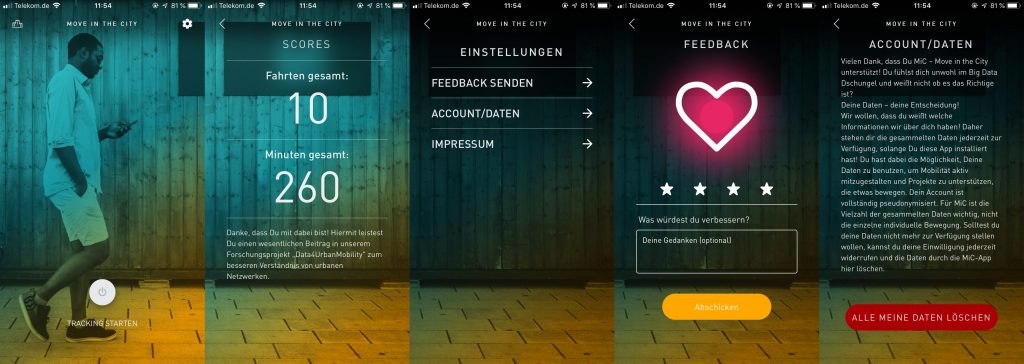
von links nach recht: Bild1-5 MIC App Interface – Attribution-NonCommercial-ShareAlike 4.0 International (CC BY-NC-SA 4.0)
Die aktuelle Weiterentwicklung sieht eine Visualisierung der Routen für den jeweiligen Nutzer vor.
Um Teil der Testgruppe zu werden ist zur Zeit noch eine Anmeldung unter: www.mic-app.org notwendig. Die Anwendung ist nicht frei im App Store / GooglePlay Store zu erhalten.
Auf der Internetseite www.mic-app.org wird zusätzlich detailliert auf häufige Fragen (FAQ) zur Anwendung sowie über Entwicklungen und Neuheiten informiert
D4UM Plattform und Dashboard V2
Die neue Version der Plattform inklusive des Dashboards gibt noch detailliertere Auskünfte über die Verkehrssituation
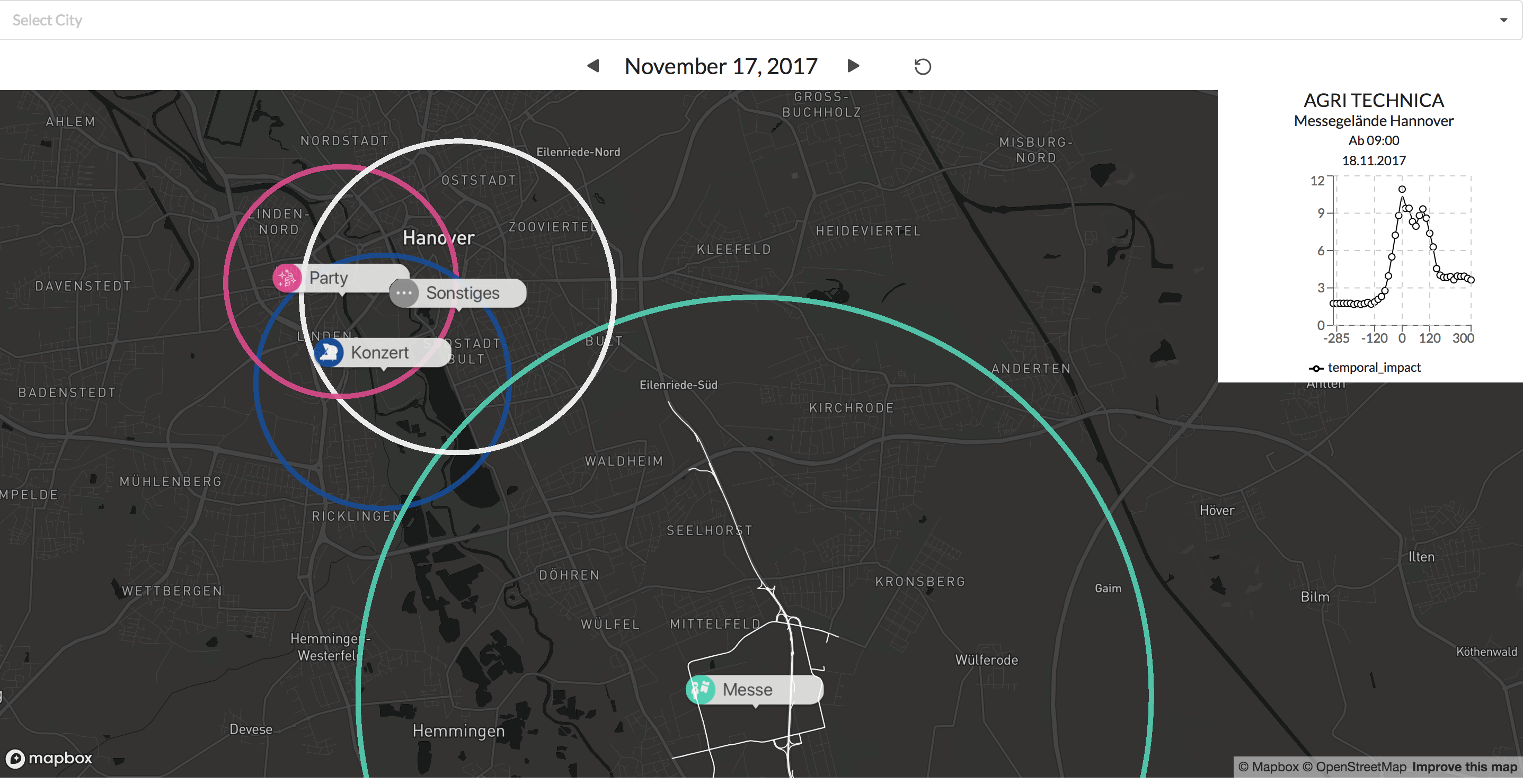
Die farblich unterschiedlichen Label lassen eine schnelle Unterscheidung zwischen den verschiedenen Event typen zu. Durch das klicken auf eines der Events wird der typically affected subgraph angezeigt für diesen Eventtyp.

Beispiele: Visualisierungen eines Konzerts und eines Fußballspiels
Zusätzlich gibt der Graph in der oberen rechten Ecke Auskunft über die Verkehrssituation vor und nach dem Eventstart.
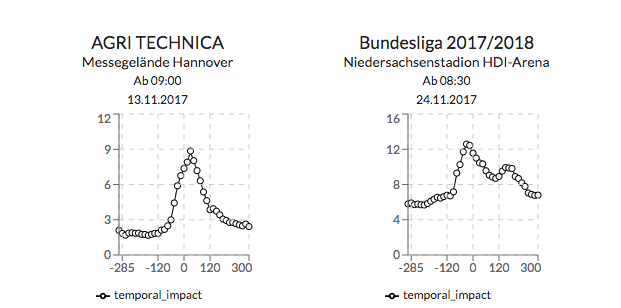
{API}
Es wurden die API Endpunkte mit zusätzlichen Information erweitert.
Diese werden mittels der als Teil der Forschung entwickelten Modellen erstellt.
Erste Version der D4UM-App bereitgestellt
Eine erste Version der D4UM-App konnte allen Partnern des Projekts zur Verfügung gestellt werden. Die App stellt eine Möglichkeit dar, sich Fahrtauskünfte mit dem öffentlichen Personennahverkehr in Niedersachsen und Bremen (Datengrundlage: EFA – elektronische Fahrplanauskunft für Niedersachsen und Bremen) ausgeben zu lassen. Im Fokus stand hierbei, dass der Nutzer schnell und einfach an die für ihn wichtigen Informationen gelangen kann, um so seine Reise möglichst simpel planen zu können.
Folgende Funktionen dienen dabei in der ersten Version der schnellen Auskunft:
Abfahrten und Verbindungen
Über die Funktion Abfahrten lassen sich Abfahrtszeiten an einer bestimmten oder an nahegelegenen Haltestellen ermitteln. Unter Verbindungen können hingegen Fahrtvorschläge von einem Startpunkt (Adresse oder Haltestelle) zu einem Zielpunkt gesucht werden. Zeiten stehen dabei auch in Echtzeit zur Verfügung, sodass auch Verspätungen direkt von dem Nutzer erkannt werden können.
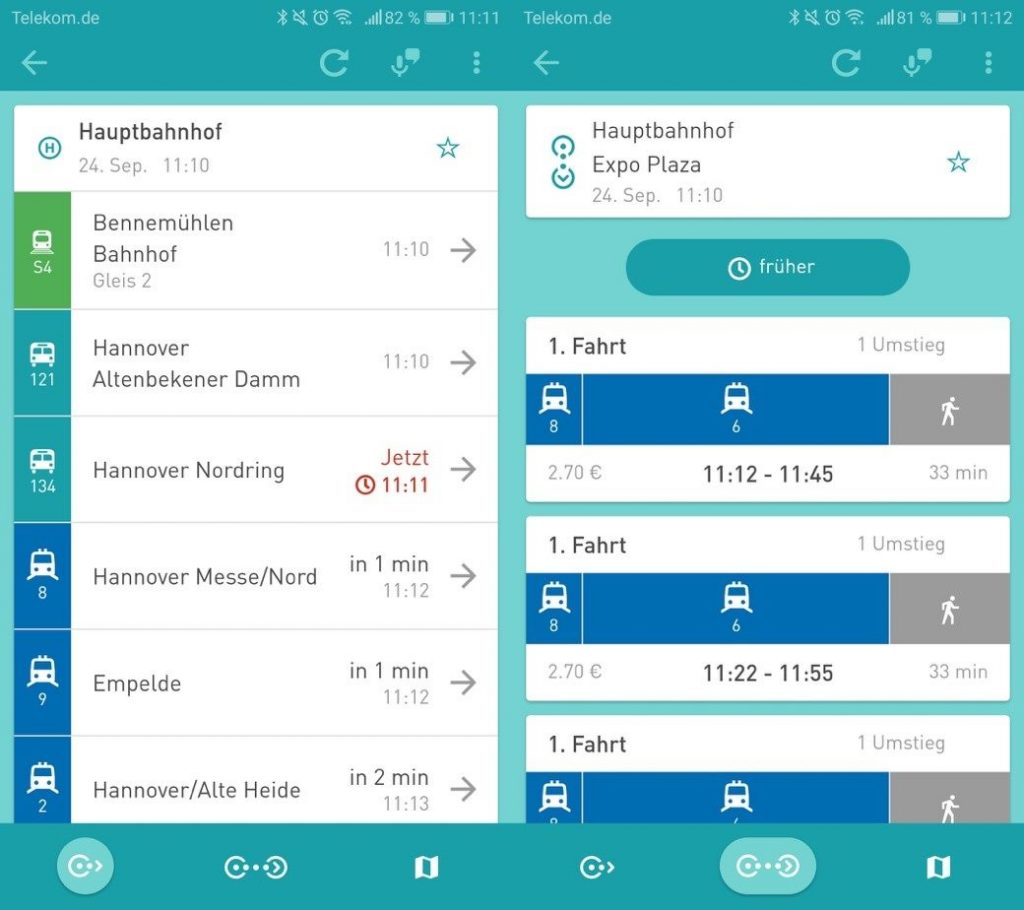
Karte
Über die Karte sind alle Haltestellen zu finden, sodass sich der Nutzer einen Überblick über die nähere Umgebung oder auch den Weg zur Haltestelle oder einem Ziel verschaffen kann.
Wird auf der Karte auf ein Haltestellensymbol oder den zugehörigen Haltestellennamen geklickt, öffnet sich der Abfahrtsmonitor zu dieser Haltestelle. Die nächsten Abfahrten können somit auch über diesen Weg aufgerufen werden.
Darüber hinaus kann sich der Nutzer auch den Verlauf seiner Fahrt anzeigen lassen.
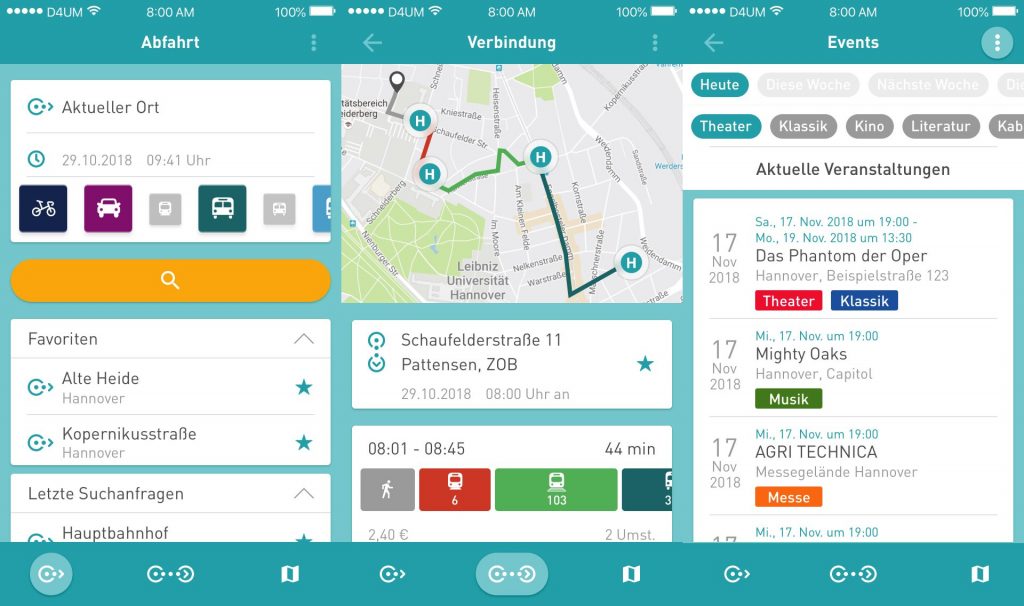
Menü/Einstellungen
Weitere Funktionen und Einstellungen finden sich ergänzend im Menü der App.
Der Nutzer bekommt hier zum einen die Möglichkeit, dass erweiterte Einstellungen zu den Suchanfragen bei Verbindungen oder Abfahrten vorgenommen werden können, und zum anderen, dass er weitere Features verwenden kann. Darunter befindet sich zum Beispiel das Feedbackformular. Hierüber kann unkompliziert Kontakt mit den Entwicklern der D4UM-App per Mail aufgenommen werden. Icons ermöglichen es, dass ein Eindruck zu der App übermittelt werden kann. Ein weiteres Feld für Freitext bietet zudem Platz für individuelle Kritik und einer Meinung zu der App. So kann in Zukunft kundennah an der App weiterentwickelt und einfach auf Wünsche und Meinungen reagiert werden.
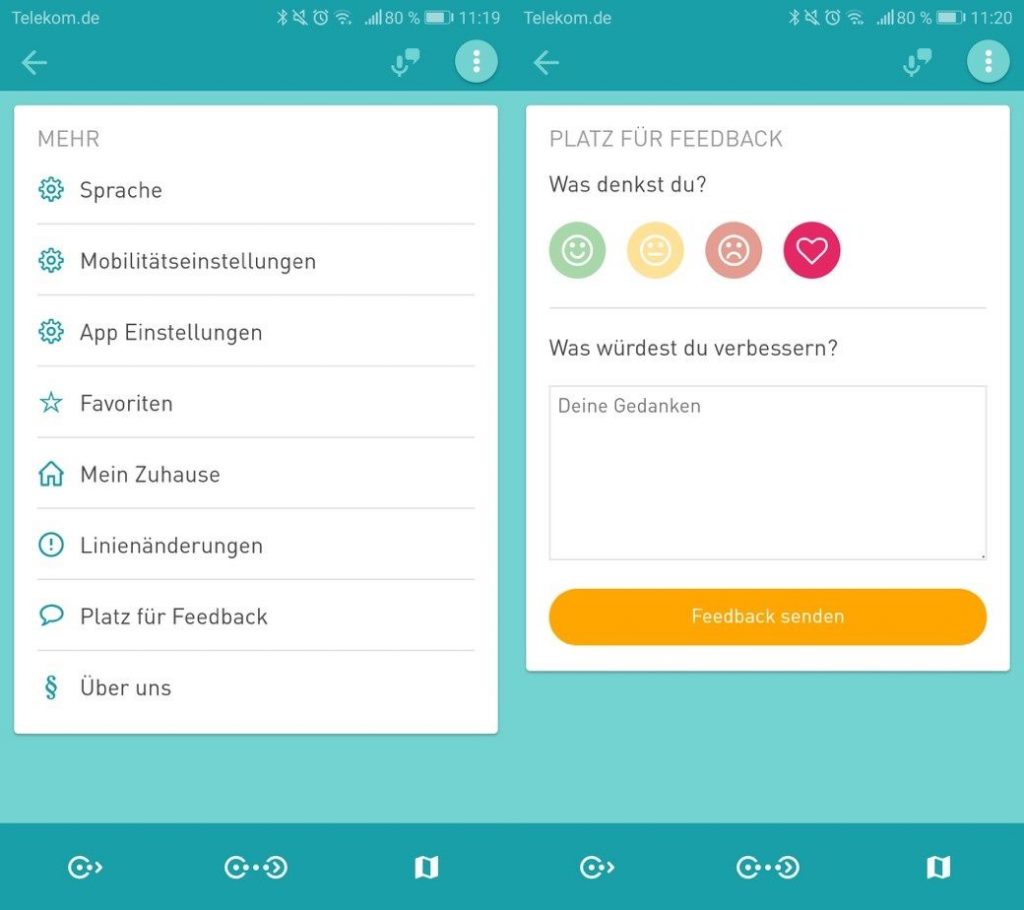
Quantifizierungen und Vorhersage von Auswirkungen von Veranstaltungen
Neue Data4UrbanMobility-Forschungsergebnisse ermöglichen es, die räumlichen Auswirkungen von Veranstaltungen zu quantifizieren und vorherzusagen. Dazu werden zusammenhängende, betroffene Straßenabschnitte in der Nähe von Veranstaltungen identifiziert. Auf dieser Grundlage kann dann die räumliche Auswirkung quantifiziert werden. Das Verfahren ist in der folgenden Grafik dargestellt.

(Karte von https://www.openstreetmap.org)
Hier in Gelb markiert ist eine Veranstaltung, in Rot betroffene Straßenabschnitte und in Dunkelblau die gemessene Auswirkung. Weiterhin wurden Verfahren des Maschinellen Lernens angewandt, um diese Auswirkungen zu prognostizieren. Dabei konnte der Fehler gegenüber bestehenden state-of-the-art Ansätzen um bis zu 40% verringert werden.
D4UM – Plattform V1 fertiggestellt
Die erste Version der Data4UrbanMobility Plattform wurde fertiggestellt. Dazu wurde zunächst eine 3-Schichten Architektur der Plattform konzipiert und implementiert. Die Plattform bietet RESTfull Webservices für Mobilitätsapplikationen wie Dashboard-Anwendungen oder Apps an. Als erste Beispielanwendung wurde dazu eine interaktive Karte entwickelt, die die Auswirkungen von Veranstaltungen visualisiert. Ein Ausschnitt aus der Anwendung ist im folgenden Screenshot zu sehen.
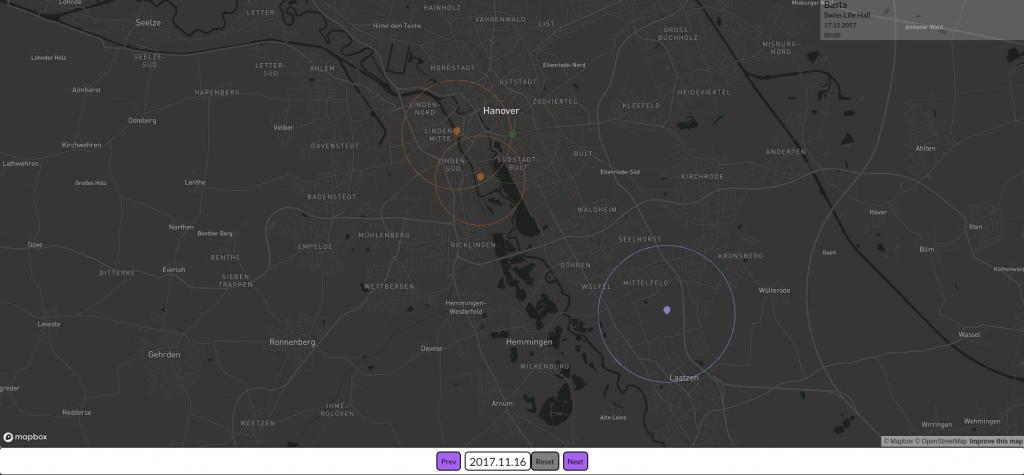
Zu sehen sind 4 Veranstaltungen in Hannover. Die Farben entsprechen dabei unterschiedlichen Veranstaltungsarten (etwa Konzerte, Messen, Fußballspiele). Die Kreise visualisieren die räumlichen Auswirkungen, die diese Veranstaltungen auf den Verkehr hatten.
Umfangreicher Anforderungskatalog
Die Data4UrbanMobility Anforderungsanalyse umfasst die Erfassung der Anforderungen der Anwendungspartner Region Hannover (RH) und Wolfsburg AG (WAG), sowie der nicht-funktionalen Anforderungen. Aus den Anforderungen der AnwendungspartnerInnen (RH und WAG), die von MOMA erhoben wurden, sind von L3S Forschungsfragen für die Datenanalyse abgeleitet worden, die sich speziell auf die Informationsbedürfnisse der AnwenderInnen beziehen und im weiteren Projektverlauf adressiert werden.
Die aktuelle Forschungsfragen adressieren insbesondere:
- Automatische Verifikation von Verkehrswarnmeldungen und Prognose von deren Auswirkungen.
- Identifikation von Veranstaltungen und Prognose verkehrsrelevanter Auswirkungen.
- Korrelation von IV-Reiseflussdaten, EFA-Querylogs, Warnmeldungen und Twitterfeeds.
- Bestimmung von optimalen Reisezeitpunkte.
Wachsende Datensammlung
Das ISU hat einen umfassende Datenmatrix mit potentiellen Quellen für mobilitätsrelevante Daten erstellt. Das von L3S entwickelte Data4UrbanMobility Datenmodell beschreibt alle projektrelevanten Daten und setzt diese in Verbindung um die Daten sowohl für die Analyse als auch für die Anwendungen und Apps einheitlich zur Verfügung zu stellen. Die ausgewählten Datenquellen sind von L3S in das Data4UrbanMobility Datenmodell überführt. Einige der Datenquellen wie EFA-logs, und IV-Daten sind dabei auf deren Qualität geprüft worden.
Um die Datenintegration zu ermöglichen sind Werkzeuge zur Extraktion der relevanten Daten aus Mobilitätsrelevanten Datenquellen entwickelt worden:
- Straßen- und Graphextraktion aus OpenStreetMap
- EFA-Anfragen Bulkloader für die Extraktion der ÖPNV Anfragen aus EFA Logs
- Integration von Daten aus dem Zentralen Haltestellen Verzeichnis (ZHV) inklusive Verknüpfung der Daten mit den EFA-Anfragen
Die aktuelle Datensammlung (Stand: 12 Dezember 2017) umfasst:
EFA-Logs: 17 Mio. Suchanfragen
IV-Daten: 174 Tsd. Straßen, alle 15 Minuten
GTFS-Daten: 90 Tsd. Haltestellen, 2,6 Tsd. Routen
Wetter: Radolan Regenraster
Twitter: 2,5 Mio. Tweets ab Juni 2017
OSM: 440 Tsd. Straßen
Events: 21 Tsd. Veranstaltungen (14.08.2016-17.07.2018)
Warnmeldungen: 13 Tsd. Warnmeldungen (ab 06.2017)
Visualisierungen der ÖPNV Informationen
Zur intuitiven Analyse von mobilitätsrelevanten Informationen, insbesondere von ÖPNV Informationen, wurde von den PROJEKTIONISTEN (PROJ) eine Dashboard-Webapplikation konzipiert. Erste Prototypen visualisieren Anfragen an das regionale Fahrplanauskunftsystem EFA (www.efa.de) und dienen als Ausgangsbasis für explorative Analysen und die Implementierung der produktiven Version des Dashboards. Im Folgenden ist eine im Dashboard integrierte Visualisierung der häufigsten Start- und Ziel-punkte zu sehen.
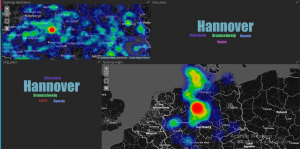
Analysen der EFA-Logs
Als erste Forschungsfrage wird aktuell die Analyse der Auswirkungen der Veranstaltungen auf dem ÖPNV mit Methoden des Maschinellen Lernens analysiert. Hierzu wurden in explorativen Datenanalysen der Einfluss von großen Veranstaltungen wie z.B. Fussballspielen und mittelgroßen Veranstaltungen, etwa Konzerte, auf Anfragen an den ÖPNV betrachtet. Als Grundlage für umfassende Analysen wurden mit Hilfe visueller Methoden exemplarisch Korrelation zwischen ÖPNV-Nachfrage und Veranstaltungszeiträumen detektiert.
Dabei zeichnen sich z.B. für Hannovers Innenstadt klare, sternförmige Muster ab, die zentrale Mobilitätsknoten identifizieren.

Das Bild stellt die Luftlinie zwischen Start- und Ziel-Ort der Anfragen dar. Dabei entsprechen dunklere Farben häufigeren Strecken. Hier werden deutlich Hannover Hauptbahnhof und Hannover Kröpcke (die zentrale U-Bahn Station) als Mobilitätsknoten identifiziert.
Analysen der Nachfrage für einzelne Stationen lassen wochentagspezifische Muster erkennen.
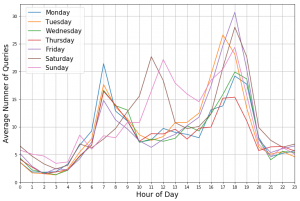
Hier dargestellt sind die durchschnittliche Anzahl der Anfragen mit der Ziel-Haltestelle “Hannover Stadionbrücke”. Zu erkennen sind vor allem Unterschiede zwischen Werktagen und dem Wochenende.
Auch der Einfluss von Veranstaltungen kann mit Hilfe der Anfragen visualisiert werden:
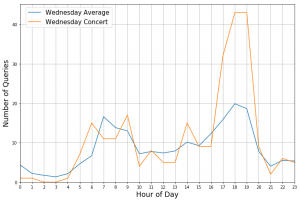
Dargestellt sind die Anzahl der Anfragen mit Ziel “Hannover Stadionbrücke” für Mittwoch, den 26.04.2017 (Orange) sowie die durchschnittlichen Anzahl von Anfragen, die mittwochs mit gleichem Ziel gestellt wird (Blau).
An diesem Tag fand in einer nahe gelegenen Konzerthalle ein Konzert statt, das um 20 Uhr begann. Die signifikante Abweichung zwischen 17 und 19 Uhr wurde sehr wahrscheinlich von den anreisenden Gästen verursacht wurde. Dies illustriert, dass Anfragen an den ÖPNV eine wertvolle Informationsquelle sein können, um Prognosen über die Auswirkung von Veranstaltungen auf Mobilität zu erstellen.
- SIREN: Scalable isotropic recursive column multimodal neural architecture. Truchan, Hubert; Farag, Alan; Ahmadi, Zahra (2026). 125 103500.
- SIREN: Scalable isotropic recursive column multimodal neural architecture. Truchan, Hubert; Farag, Alan; Ahmadi, Zahra (2026). 125 103500.
- LBFT-DAG: A Swift, Leader-Driven, DAG-Based Consortium Blockchain with Byzantine Fault-Tolerance. Dong, Xuewen; Liu, Yi; Li, Teng; Guo, Xiaojie; Tian, Youliang; Shen, Yulong; Du, Xiaojiang (2025). 1–10.
- Identifying the key components of a diet and lifestyle screener for people living with and beyond cancer: an e-Delphi study. Chaplin, Alice; Prohens, Lara; Wordsworth, Janna; Obrador-Hevia, Antònia; Guillot, Monica; Ricci-Cabello, Ignacio; Romaguera, Dora; Sesé, Albert (2025). 15(8) e097084-e097084.
- AsyncSC: An Asynchronous Sidechain for Multi-Domain Data Exchange in Internet of Things. Yang, Lingxiao; Dong, Xuewen; Wan, Zhiguo; Gao, Sheng; Tong, Wei; Lu, Di; Shen, Yulong; Du, Xiaojiang (2025). 1–10.
- Optimizing 5G Protocol Fuzzing: Structure-Aware Techniques and Feedback Integration. Canal, Sara Da; Mancini, Francesco; Mastrobattista, Luca; Bianchi, Giuseppe in CEUR Workshop Proceedings, G. Costa, R. Montanari, M. Carminati, G. Sciarretta (eds.) (2025). (Vol. 3962)
- VMORPH: A Virtualization/Metamorphic Framework for Binary Obfuscation and Intellectual Property Protection. Caliandro, Pierciro; Ciccaglione, Matteo; Pepe, Andrea; Bianchi, Giuseppe; Pellegrini, Alessandro in CEUR Workshop Proceedings, G. Costa, R. Montanari, M. Carminati, G. Sciarretta (eds.) (2025). (Vol. 3962)
- 5G Security Assurance: Lessons Learned from 3GPP SCAS Tests on Virtualized Network Architectures. Mancini, Francesco; Cannella, Lorenzo; Messina, Giorgia; Centenaro, Marco; Pietro, Ivan Di; Greco, Alessandro; Persia, Samuela; Cuomo, Francesca; Bianchi, Giuseppe in CEUR Workshop Proceedings, G. Costa, R. Montanari, M. Carminati, G. Sciarretta (eds.) (2025). (Vol. 3962)
- Solving Random Planted CSPs below the nk/2. Basu, Arpon; Hsieh, Jun-Ting; Lin, Andrew D.; Manohar, Peter (2025).
- Exploring climate‐related gut microbiome variation in bumble bees: An experimental and observational perspective. Maihoff, Fabienne; Bofinger, Lukas; Brenzinger, Kristof; Keller, Alexander; Classen, Alice (2025). 106(3) e70066.
- Common ground improves learning with conversational agents. Körner, Anita; Tolzin, Antonia; Janson, Andreas; Leimeister, Jan Marco; Rummer, Ralf (2025).
- Spatially-Aware NFV Orchestration for Dynamic LEO Satellite Management in 6G Networks. Acosta, Jose Avila; Rouzegar, Hossein; Augé, Anna Calveras; de Azua, Joan Adrià Ruiz (2025). 274–279.
- Nonastreda multimodal dataset for efficient tool wear state monitoring. Truchan, Hubert; Ahmadi, Zahra (2025). 62 111905.
- Nonastreda multimodal dataset for efficient tool wear state monitoring. Truchan, Hubert; Ahmadi, Zahra (2025). 62 111905.
- RLFuzz: Accelerating Hardware Fuzzing with Deep Reinforcement Learning. Götz, Raphael; Sendner, Christoph; Ruck, Nico; Rostami, Mohamadreza; Dmitrienko, Alexandra; Sadeghi, Ahmad-Reza (2025).
- Secure Device Authentication for MmWave MIMO Systems via Mutual Coupling and Spatial AoA. Teng, Yulin; Zhang, Pinchang; Zhao, Shuangrui; Jiang, Xiaohong; Shen, Yulong; Xiao, Fu (2025). 1–10.
- Towards an Empirical Study on Transient Phases of Microservice Applications Rohwer, Ivo; Straesser, Martin; Lubas, Yannik; Kounev, Samuel (2024).
- MAPPO-based Predictive Auto-Scaling Algorithm in Edge Cloud Clusters. Tian, Wenling; Shi, Tianyi; Zhao, Wen; Huang, Rong; Zhang, Tiankui (2024). 191–196.
- HEAL: Performance Troubleshooting Deep inside Data Center Hosts. Pan, Yicheng; Zhang, Yang; Bi, Tingzhu; Han, Linlin; Zhang, Yu; Ma, Meng; Shen, Xiangzhuang; Jiang, Xinrui; Wang, Feng; Liu, Xian; Wang, Ping M. Garetto, A. Marin, F. Ciucu, G. Fanti, R. Righter (eds.) (2024). 41–42.
- A Phenotypic Learning Classifier System for Problems with Continuous Features. Liu, Yi; Cui, Yu; Cheng, Wen; Browne, Will Neil; Xue, Bing; Zhu, Chengyuan; Zhang, Yiding; Sheng, Mingkai; Zeng, Lingfang X. Li, J. Handl (eds.) (2024).
- A Case Study of an Hybrid RF and Optical Inter-Satellite Link Terminal to Enhance Optical Pointing. Fernández-Niño, Elena; Fraire, Juan A.; Figuerola, Sergi; Camps, Adriano; de Azua, Joan Adrià Ruiz (2024). 640–645.
- PlantoGraphy: Incorporating Iterative Design Process into Generative Artificial Intelligence for Landscape Rendering. Huang, Rong; Lin, Haichuan; Chen, Chuanzhang; Zhang, Kang; Zeng, Wei F. ’Floyd’ Mueller, P. Kyburz, J. R. Williamson, C. Sas, M. L. Wilson, P. O. T. Dugas, I. Shklovski (eds.) (2024). 168:1–168:19.
- Towards an Empirical Study on Transient Phases of Microservice Applications Rohwer, Ivo; Straesser, Martin; Lubas, Yannik; Kounev, Samuel (2024).
- Evaluation method and case study of satellite quantum key distribution for terrestrial networks. Jordán-Parra, Javier; Garcia-Romero, Marina; Figuerola, Sergi; de Azua, Joan Adrià Ruiz; Paradells, Josep (2024). 694–699.
- Towards an Empirical Study on Transient Phases of Microservice Applications Rohwer, Ivo; Straesser, Martin; Lubas, Yannik; Kounev, Samuel (2024).
- Towards an Empirical Study on Transient Phases of Microservice Applications Rohwer, Ivo; Straesser, Martin; Lubas, Yannik; Kounev, Samuel (2024).
- Architecture of an IoT Platform for the Optimization of Water Resources in Community Kitchens in Cali, Colombia. Giraldo, Diana M.; Sarria, Nancy Vásquez; V., Juan M. Núñez; Flórez, Sebastián López; la Prieta, Fernando De in Lecture Notes in Networks and Systems, P. Novais, P. B. D., I. Satoh, V. J. Inglada, S. Rodríguez-González, E. Jove-Pérez, J. Parra-Domínguez, P. Chamoso, R. S. Alonso (eds.) (2024). (Vol. 1279) 167–178.
- SUNRISE App: A tool to validate the characteristics of an infocommunicational model capable of potentiating social and emotional education for high school students. Magalhães, Raquel; Riba, Bruna; Paralta, Tiago; Neves, João; Carlos, Vânia; Mercader, Cristina; Mealha, Óscar (2024). 236–242.
- AI-Based Recommendation System for the Retail Industry. Echeverry, Ana María López; Isaza, Juan Manuel Velásquez; Flórez, Sebastián López; la Prieta, Fernando De in Lecture Notes in Networks and Systems, P. Novais, P. B. D., I. Satoh, V. J. Inglada, S. Rodríguez-González, E. Jove-Pérez, J. Parra-Domínguez, P. Chamoso, R. S. Alonso (eds.) (2024). (Vol. 1279) 55–64.
- Hair‐based minimally invasive barcoding of bumblebees. Rongstock, Lydia; Schardt, Leonie; Maihoff, Fabienne; Grünewald, Bernd; Bálint, Miklós (2024). 18(2) 127–139.
- Improved Tree-seed Algorithm for Disassembly Line Balancing Problem Considering Ergonomics. Xie, Xinlan; Zhang, Zeqiang; Guo, Lei; Hu, Qiyi (2023). 208–215.
- Inter-Satellite Link Prediction for Non-Terrestrial Networks Using Supervised Learning. Ferrer, Estel; Escrig, Josep; de Azua, Joan Adrià Ruiz (2023). 258–263.
- A New JSCC Scheme for Transmission of Gaussian Sources Over AWGN Channels. Liang, Jifan; Zhu, Tingting; Wei, Baodian; Ma, Xiao (2023). 1–6.
- Privileged Anatomical and Protocol Discrimination in Trackerless 3D Ultrasound Reconstruction. Li, Qi; Shen, Ziyi; Li, Qian; Barratt, Dean C.; Dowrick, Thomas; Clarkson, Matthew J.; Vercauteren, Tom; Hu, Yipeng in Lecture Notes in Computer Science, B. Kainz, J. A. Noble, J. A. Schnabel, B. Khanal, J. P. Müller, T. G. Day (eds.) (2023). (Vol. 14337) 142–151.
- Advancements in Video-Based Insect Tracking: A Bibliometric Analysis to A Short Survey. Adjé, Erick A.; Ahouandjinou, Arnaud S. R. M.; Delmaire, Gilles; Roussel, Gilles; Houndji, Vinasétan Ratheil (2023). 75–82.
- SEBD: Sensor Emulation Based Backdoor for Autopilot. Wang, Yue; Yang, Chao; Xi, Ning; Shen, Yulong; Ma, Jianfeng N. Kawaguchi, K. Yasumoto, T. Riedel, A. Y. Ding (eds.) (2023). 265–269.
- Is It the End? Guidelines for Cinematic Endings in Data Videos. Xu, Xian; Wu, Aoyu; Yang, Leni; Wei, Zheng; Huang, Rong; Yip, David; Qu, Huamin A. Schmidt, K. Väänänen, T. Goyal, P. O. Kristensson, A. Peters, S. Mueller, J. R. Williamson, M. L. Wilson (eds.) (2023). 171:1–171:16.
- Dissecting Overheads of Service Mesh Sidecars. Zhu, Xiangfeng; She, Guozhen; Xue, Bowen; Zhang, Yu; Zhang, Yongsu; Zou, Xuan Kelvin; Duan, Xiongchun; He, Peng; Krishnamurthy, Arvind; Lentz, Matthew; Zhuo, Danyang; Mahajan, Ratul (2023). 142–157.
- Sniffer Faster R-CNN: A Joint Camera-LiDAR Object Detection Framework with Proposal Refinement. Dhakal, Sudip; Chen, Qi; Qu, Deyuan; Carrillo, Dominic; Yang, Qing; Fu, Song (2023). 1–10.
- Ternary Convolutional LDGM Codes with Applications to Gaussian Source Compression. Zhu, Tingting; Liang, Jifan; Ma, Xiao (2022). 73–78.
- An Empirical Study on Knowledge-Network-Based Translation Learning. Mu, Yuanyuan; Li, Qianyu; Du, Lizhen in Lecture Notes in Computer Science, C. S. González-González, B. Fernández-Manjón, F. W. B. Li, F. J. García-Peñalvo, F. Sciarrone, M. Spaniol, A. García-Holgado, M. Area-Moreira, M. L. Hemmje, T. Hao (eds.) (2022). (Vol. 13869) 482–490.
- A Study on Knowledge Network Acceptability Facilitated by a Computer-Based Translation Learning Platform. Mu, Yuanyuan; Du, Lizhen; Li, Qianyu in Lecture Notes in Computer Science, C. S. González-González, B. Fernández-Manjón, F. W. B. Li, F. J. García-Peñalvo, F. Sciarrone, M. Spaniol, A. García-Holgado, M. Area-Moreira, M. L. Hemmje, T. Hao (eds.) (2022). (Vol. 13869) 445–459.
- Quantum AI: Achievements and Challenges in the Interplay of Quantum Computing and Artificial Intelligence. Pérez, Iñaki Fernández; la Prieta, Fernando De; Rodríguez-González, Sara; Corchado, Juan M.; Prieto, Javier in Lecture Notes in Networks and Systems, V. Julián, J. Carneiro, R. S. Alonso, P. Chamoso, P. Novais (eds.) (2022). (Vol. 603) 155–166.
- Automated Counting via Multicolumn Network and CytoSMART Exact FL Microscope. Flórez, Sebastián López; González-Briones, Alfonso; Hernández, Guillermo; la Prieta, Fernando De in Lecture Notes in Networks and Systems, V. Julián, J. Carneiro, R. S. Alonso, P. Chamoso, P. Novais (eds.) (2022). (Vol. 603) 207–218.
- Multi-antenna covert communications in random wireless networks with full-duplex relay. Liu, Yan; Wu, Huihui; Shen, Yulong; Jiang, Xiaohong J. Hong, M. Bures, J. W. Park, T. Cerný (eds.) (2022). 1960–1966.
- A New Framework for Proving Coding Theorems for Linear Codes. Ma, Xiao; Wang, Yixin; Zhu, Tingting (2022). 2768–2773.
- Machine Learning and Deep Learning Techniques for Epileptic Seizures Prediction: A Brief Review. Hernández, Marco; Canal-Alonso, Angel; la Prieta, Fernando De; Rodríguez, Sara; Prieto, Javier; Corchado, Juan Manuel in Lecture Notes in Networks and Systems, F. Fdez-Riverola, M. Rocha, M. S. Mohamad, S. Caraiman, A. B. G. González (eds.) (2022). (Vol. 553) 13–21.
- Covid-19 Tweets Analysis with Topic Modeling. Jia, Shichao; Chen, Qi; Wang, Wei (2021). 68–74.
- Acufenometry in the Self-management of Tinnitus: A Revised Interface to Improve the User Experience. Vittorini, Pierpaolo; Chamoso, Pablo; la Prieta, Fernando De in Lecture Notes in Networks and Systems, M. Rocha, F. Fdez-Riverola, M. S. Mohamad, R. Casado-Vara (eds.) (2021). (Vol. 325) 22–30.
- Multi-task Learning for Bias-Free Joint CTR Prediction and Market Price Modeling in Online Advertising. Yang, Haizhi; Wang, Tengyun; Tang, Xiaoli; Li, Qianyu; Shi, Yueyue; Jiang, Siyu; Yu, Han; Song, Hengjie G. Demartini, G. Zuccon, J. S. Culpepper, Z. Huang, H. Tong (eds.) (2021). 2291–2300.
- Balancing of Bike-Sharing System via Constrained Model Predictive Control. Chen, Yuguang; Zeng, Yan; Wu, Junjun; Li, Qian; Wu, Zhou in Communications in Computer and Information Science, H. Zhang, Z. Zhang, Z. Wu, T. Hao (eds.) (2020). (Vol. 1265) 502–512.
- Extraction of Travellers’ Preferences Using Their Tweets. Cea-Morán, Juan J.; González-Briones, Alfonso; la Prieta, Fernando De; Prat-Pérez, Arnau; Prieto, Javier in Advances in Intelligent Systems and Computing, P. Novais, G. V. Vercelli, J. L. Larriba-Pey, F. Herrera, P. Chamoso (eds.) (2020). (Vol. 1239) 224–235.
- Communication and Computation Resource Allocation for End-to-End Slicing in Mobile Networks. Tong, Zhou; Zhang, Tiankui; Zhu, Yutao; Huang, Rong (2020). 1286–1291.
- A new CoAP congestion control scheme considering strong and weak RTT for IoUT. Seo, Junho; Lee, Sungwon; Khan, Muhammad Toaha Raza; Kim, Dongkyun C.-C. Hung, T. Cerný, D. Shin, A. Bechini (eds.) (2020). 2158–2162.
- Reusable acoustic tweezers enable 2D patterning of microparticles in microchamber on a disposable silicon chip superstrate. Qian, Jingui; Ren, Jifeng; Liu, Yi; Lam, Raymond H. W.; Lee, Joshua E.-Y. (2020). 1–4.
- Strategic Analysis of User Association Based on Power-Domain Non-Orthogonal Multiple Access in Visible Light Communication Multi-cell Networks. Tao, Siyu; Yu, Hongyi; Li, Qing; Tang, Yanqun (2019). 710–714.
- Attention-Based Neural Tag Recommendation. Yuan, Jiahao; Jin, Yuanyuan; Liu, Wenyan; Wang, Xiaoling in Lecture Notes in Computer Science, G. Li, J. Yang, J. Gama, J. Natwichai, Y. Tong (eds.) (2019). (Vol. 11447) 350–365.
- A new CoAP congestion control scheme using message loss feedback for IoUT. Kim, Minseok; Lee, Sungwon; Khan, Muhammad Toaha Raza; Seo, Junho; Bae, Yeongjoon; Jeong, Yonghwan; Kim, Dongkyun C.-C. Hung, G. A. Papadopoulos (eds.) (2019). 2385–2390.
- Edge Computing Architectures in Industry 4.0: A General Survey and Comparison. Sittón-Candanedo, Inés; Alonso, Ricardo S.; Rodríguez-González, Sara; Coria, José Alberto García; la Prieta, Fernando De in Advances in Intelligent Systems and Computing, F. Martínez-Álvarez, A. T. Lora, J. A. S. Muñoz, H. Quintián, E. Corchado (eds.) (2019). (Vol. 950) 121–131.
- Adaptive Fault-Tolerant Tracking Control Algorithm for IoT Systems: Smart Building Case Study. Casado-Vara, Roberto; la Prieta, Fernando De; Rodríguez, Sara; Sittón, Inés; Calvo-Rolle, José Luís; Venayagamoorthy, Ganesh Kumar; Vega, Pastora; Prieto, Javier in Advances in Intelligent Systems and Computing, F. Martínez-Álvarez, A. T. Lora, J. A. S. Muñoz, H. Quintián, E. Corchado (eds.) (2019). (Vol. 950) 481–490.
- Predicting circRNA-disease associations using deep generative adversarial network based on multi-source fusion information. Wang, Lei; You, Zhu-Hong; Li, Li-Ping; Zheng, Kai; Wang, Yan-Bin I. Yoo, J. Bi, X. Hu (eds.) (2019). 145–152.
- Answer-Supervised Question Reformulation for Enhancing Conversational Machine Comprehension. Li, Qian; Su, Hui; Niu, Cheng; Wang, Daling; Li, Zekang; Feng, Shi; Zhang, Yifei A. Fisch, A. Talmor, R. Jia, M. Seo, E. Choi, D. Chen (eds.) (2019). 38–47.
- A Brief Survey on Nature-Inspired Metaheuristics for Feature Selection in Classification in this Decade. Liu, Wei; Wang, Jianyu (2019). 424–429.
- MASPI: A Multi Agent System for Prediction in Industry 4.0 Environment. Sittón-Candanedo, Inés; Rodríguez-González, Sara; la Prieta, Fernando De; Arrieta, Angélica González in Advances in Intelligent Systems and Computing, M. Graña, J. M. López-Guede, O. Etxaniz, Álvaro Herrero, J. A. Sáez, H. Quintián, E. Corchado (eds.) (2018). (Vol. 771) 197–206.
- Towards the Automatic Identification and Monitoring of Radicalization Activities in Twitter. Sánchez, Daniel López; Herrero, Jorge Revuelta; la Prieta, Fernando De; Corchado, Juan M. in Communications in Computer and Information Science, L. Uden, B. Hadzima, I.-H. Ting (eds.) (2018). (Vol. 877) 589–599.
- An All-Silicon Double Differential MEMS Accelerometer with Improved Thermal Stability. Xu, Wei; Tang, Bin; Xie, Guofen; Yang, Jie (2018). 1–4.
- Decision Support for Digital Marketing Through Virtual Organizations - Influencers on Twitter. Gutiérrez, Rebeca Cordero; la Prieta Pintado, Fernando De; Rodríguez, Juan M. Corchado in Communications in Computer and Information Science, L. Uden, B. Hadzima, I.-H. Ting (eds.) (2018). (Vol. 877) 574–585.
- Use of Gamification Techniques to Encourage Garbage Recycling. A Smart City Approach. González-Briones, Alfonso; Chamoso, Pablo; Rivas, Alberto; Rodríguez, Sara; la Prieta, Fernando De; Prieto, Javier; Corchado, Juan M. in Communications in Computer and Information Science, L. Uden, B. Hadzima, I.-H. Ting (eds.) (2018). (Vol. 877) 674–685.
- Human-Computer Interaction in Currency Exchange. Rivas, Alberto; Martín-Limorti, Javier J.; Chamoso, Pablo; González-Briones, Alfonso; la Prieta, Fernando De; Rodríguez, Sara in Communications in Computer and Information Science, L. Uden, B. Hadzima, I.-H. Ting (eds.) (2018). (Vol. 877) 390–400.
- The dancing dudu: women’s initiation in the Namib desert during the second millennium AD. Kinahan, John (2017). 91(358) 1043–1057.
- An App Supporting the Self-management of Tinnitus. Chamoso, Pablo; la Prieta, Fernando De; Eibenstein, Alberto; Tizio, Angelo; Vittorini, Pierpaolo in Advances in Intelligent Systems and Computing, F. Fdez-Riverola, M. S. Mohamad, M. P. Rocha, J. F. D. Paz, T. Pinto (eds.) (2017). (Vol. 616) 83–91.
- Spanish Patent Landscape 2013-2016. Vázquez-Ingelmo, Andrea; González, Ana Belén Gil; Blanco-Mateos, Angel-Luis; la Prieta, Fernando De; de Luis-Reboredo, Ana in Advances in Intelligent Systems and Computing, H. P. García, J. Alfonso-Cendón, L. Sánchez-González, H. Quintián, E. Corchado (eds.) (2017). (Vol. 649) 237–246.
- Interregional European Cooperation platform to promote sustainable transport through ICT: an overview of best practices. Tafidis, Pavlos; Bandeira, Jorge M. (2017). 255–260.
- Points of interest detection for map-aided PDR in combined outdoor-indoor spaces. Taia-Alaoui, Fadoua; Renaudin, Valérie; Bétaille, David (2017). 1–8.
- OpinionWalk: An efficient solution to massive trust assessment in online social networks. Liu, Guangchi; Chen, Qi; Yang, Qing; Zhu, Binhai; Wang, Honggang; Wang, Wei (2017). 1–9.
- A multi-hypothesis particle filtering approach for pedestrian dead reckoning. Taia-Alaoui, Fadoua; Bétaille, David; Renaudin, Valérie (2016). 1–8.
- Implementation of gaits for achieving omnidirectional walking in a quadruped robot. Kumar, T. Komal; Kumar, Rajesh; Mogily, S.; Goel, Divyanshu; Pareekutty, Nahas; Shah, Suril Vijaykumar; Krishna, K. Madhava (2015). 33:1–33:6.
- Wireless Sensor Networks to Monitoring Elderly People in Rural Areas. Villarrubia, Gabriel; de Paz, Juan Francisco; la Prieta, Fernando De; Sánchez, Antonio Juan in Advances in Intelligent Systems and Computing, C. Ramos, P. Novais, C. E. Nihan, J. M. C. Rodríguez (eds.) (2014). (Vol. 291) 171–181.
- Constructing Complex Geometries: A Case Study on the Cité des Civilisations du Vin in Bordeaux, France. Soquier, Benjamin; Mizzi, Raphaël; Dureisseix, Daphné; Valette, Jean-Baptiste P. Block, J. Knippers, N. J. Mitra, W. Wang (eds.) (2014). 323–335.
- Complete modelling of AVB in Network Calculus Framework. de Azua, Joan Adrià Ruiz; Boyer, Marc M. Jan, B. B. Hedia, J. Goossens, C. Maiza (eds.) (2014). 55.
- Integrated computational methods for traffic emissions route assessment. Gazis, Andreas; Fontes, Tânia; Bandeira, Jorge M.; Pereira, Sérgio R.; Coelho, Margarida C. S. Winter, M. Müller-Hannemann (eds.) (2012). 8–13.
- Fusion of Time-of-Flight and Stereo for Disambiguation of Depth Measurements. Choi, Ouk; Lee, Seungkyu in Lecture Notes in Computer Science, K. M. Lee, Y. Matsushita, J. M. Rehg, Z. Hu (eds.) (2012). (Vol. 7727) 640–653.
- Cloud-IO: Cloud Computing Platform for the Fast Deployment of Services over Wireless Sensor Networks. Tapia, Dante I.; Alonso, Ricardo S.; García, Óscar; la Prieta, Fernando De; Lancho, Belén Pérez in Advances in Intelligent Systems and Computing, L. Uden, F. Herrera, J. B. Pérez, J. M. C. Rodríguez (eds.) (2012). (Vol. 172) 493–504.
- Hybrid network intrusion detection system using expert rule based approach. Aneetha, A. S.; Indhu, T. S.; Sundan, Bose N. Meghanathan, M. Wozniak (eds.) (2012). 47–51.
- The Learners’ User Classes in the TERENCE Adaptive Learning System. Mascio, Tania Di; Vittorini, Pierpaolo; Gennari, Rosella; Melonio, Alessandra; la Prieta Pintado, Fernando De; Alrifai, Mohammad C. Giovannella, D. G. Sampson, I. Aedo (eds.) (2012). 572–576.
- Fault class prioritization in Boolean expressions. Wang, Ziyuan; Chen, Zhenyu; Chen, Tsong Yueh; Xu, Baowen S. Ossowski, P. Lecca (eds.) (2012). 1191–1196.
- Mobility management scheme for supporting legacy clients in IEEE 802.11s WMNs. Lee, Sungwon; Jeong, Hong-Jong; Kim, Dongkyun (2012). 102–103.
- Probability model-adaptive coding of point clouds with octree decomposition. Cai, Kangying; Jiang, Wenfei; Ma, Teng; Tian, Jiang; Wang, Wencheng; Luo, Tao Z. Pan (ed.) (2011). 33:1.
- Harmonic distortion free distance estimation in ToF camera. Kang, Byongmin; Kim, Seong-Jin; Lee, Seungkyu; Lee, KeeChang; Kim, James D. K.; Kim, Chang-Yeong in SPIE Proceedings, J.-A. Beraldin, G. S. Cheok, M. B. McCarthy, U. Neuschaefer-Rube, A. Baskurt, I. E. McDowall, M. Dolinsky (eds.) (2011). (Vol. 7864) 786403.
- A System for Multi-label Classification of Learning Objects. Batista, Vivian F. López; la Prieta Pintado, Fernando De; Gil, Ana Belén; Rodríguez, Sara; García, María N. Moreno in Advances in Intelligent and Soft Computing, E. Corchado, V. Snásel, J. Sedano, A. E. Hassanien, J. L. Calvo-Rolle, D. Slezak (eds.) (2011). (Vol. 87) 523–531.
- Cloud Computing Integrated into Service-Oriented Multi-Agent Architecture. Rodríguez, Sara; Tapia, Dante I.; Sanz, Eladio; Zato, Carolina; la Prieta, Fernando De; Gil, Óscar in IFIP Advances in Information and Communication Technology, Ángel O. Bas, R. D. Franco, P. Gómez-Gasquet (eds.) (2010). (Vol. 322) 251–259.
- Multiagent Systems and Wearable Devices: Helping People Live Healthier. Fraile, Juan A.; Zato, Carolina; Gil, Óscar; la Prieta, Fernando De in Advances in Intelligent and Soft Computing, J. C. Augusto, J. M. Corchado, P. Novais, C. Analide (eds.) (2010). (Vol. 72) 11–18.
- A new modular genetic programming for finding attractive technical patterns in stock markets. Lee, Seung-Kyu; Moon, Byung Ro M. Pelikan, J. Branke (eds.) (2010). 1219–1226.
- Generating combinatorial test suite for interaction relationship. Wang, Ziyuan; Nie, Changhai; Xu, Baowen M. Pezzè (ed.) (2007). 55–61.
- Performance Evaluation of Scientific Applications on Modern Parallel Vector Systems. Carter, Jonathan; Oliker, Leonid; Shalf, John in Lecture Notes in Computer Science, M. J. Daydé, J. M. L. M. Palma, A. L. G. A. Coutinho, E. Pacitti, J. C. Lopes (eds.) (2006). (Vol. 4395) 490–503.
- Efficient Evaluation of Distance Predicates in XPath Full-Text Query. Chen, Hong; Wang, Xiaoling; Zhou, Aoying in Lecture Notes in Computer Science, H. T. Shen, J. Li, M. Li, J. Ni, W. Wang (eds.) (2006). (Vol. 3842) 76–85.
- A Performance Evaluation of the Cray X1 for Scientific Applications. Oliker, Leonid; Biswas, Rupak; Borrill, Julian; Canning, Andrew; Carter, Jonathan; Djomehri, M. Jahed; Shan, Hongzhang; Skinner, David in Lecture Notes in Computer Science, M. J. Daydé, J. J. Dongarra, V. Hernández, J. M. L. M. Palma (eds.) (2004). (Vol. 3402) 51–65.
- Si par une nuit d’hiver un voyageur : roman Calvino, Italo in Points (1981). (Vol. 81) Seuil, Paris.
- Origin and Differentiation of Human Races. Cavalli-Sforza, L. L. (1972). (1972) 15–25.
